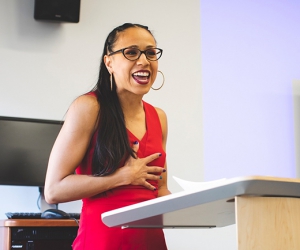
Professor’s New Book on Hispanic-Serving Institutions Receives National Attention
There are over 435 Hispanic-Serving Institutions (HSIs) in the United States—and the number is growing every year.
Gina Garcia, a University of Pittsburgh School of Education faculty member, is widely recognized as an expert in the field. After over a decade of institutional research and about 20 published articles, she published her book, Becoming Hispanic Serving Institutions, earlier this year.
Her book is one to add to the reading list.
Garcia’s book critically assesses the 21st century higher education landscape, while simultaneously inspiring student affairs practitioners and academics to transform student programming to better culturally diverse student populations.
Unlike other minority-serving institutions (MSIs), whose designation is based on the institution’s mission to serve their students, HSIs receive their designation by enrollment only. In some cases, institutions do not plan to become HSIs. As student populations shift, colleges and universities become HSIs without knowing how to effectively serve Latinx students. Despite the importance of the issue, there is little literature on the subject.
“HSI is a federal designation that was officially defined in 1992, but this designation didn’t come with a guide book. HSIs are often evaluated for their effectiveness within a system that values racially white norms and measures, thus entirely negating culturally responsive programming and pedagogy. This book is meant serve as that guide,” said Garcia.
Using empirical data collected from three HSIs in the Chicago area, Garcia defines what it means to be an HSI while sharing the stories of the faculty, staff, and students within each of the three institutions. The book’s approachable style to sharing research is meant to spark new conversations about HSI research, practice, and policy all over the country.
A product of an HSI, California State University, and member of the Latinx community herself, Garcia draws on her personal and professional experiences in her work.
“In the classroom, I actively work to engage my students in critical conversations about race and identity, while exploring how such factors influence the ways in which institutions serve culturally diverse student bodies,” said Garcia.
Although, she quickly found her student weren’t the only one with questions.
“I’ve been traveling all around the country, often times with my doctoral students in tow, giving talks to organizations all over the country almost every week. It feels amazing to share my work with others while also giving my students a first-hand view of what institution transformation looks like today,” said Garcia.
Her most recent trip with doctoral students was to the Association of the Study of Higher Education’s (ASHE) Portland Conference earlier this year, where she facilitated a talk on HSIs. Earlier this year, Garcia was elected to the ASHE board of directors.
“Without the support of my family, my colleagues, and the School of Education’s deans, I wouldn’t be able to this work. Conducting research that shapes practice and policy is a heavy weight to carry but working with others who are equally as committed to bringing equity and justice into higher education reinvigorates my desire to do this work. Seeing the impact my work has had thus far is all the more rewarding, “said Garcia.




